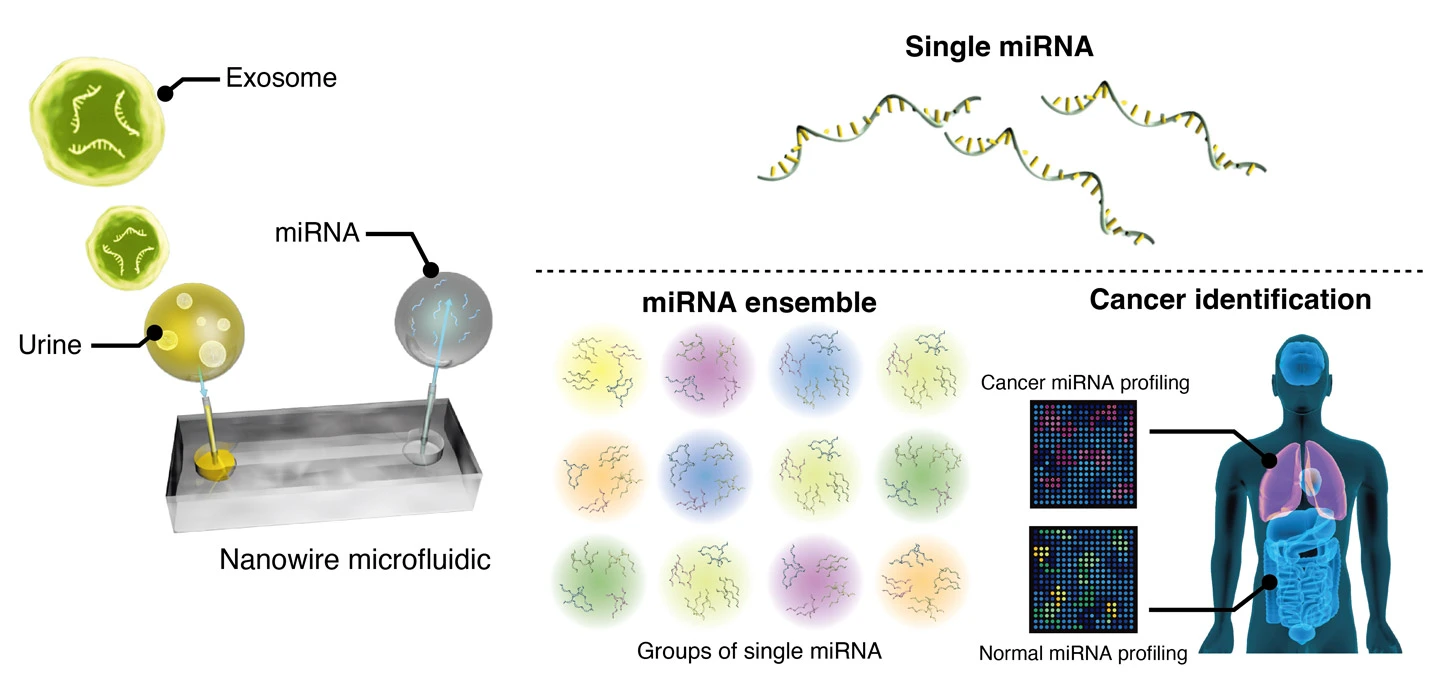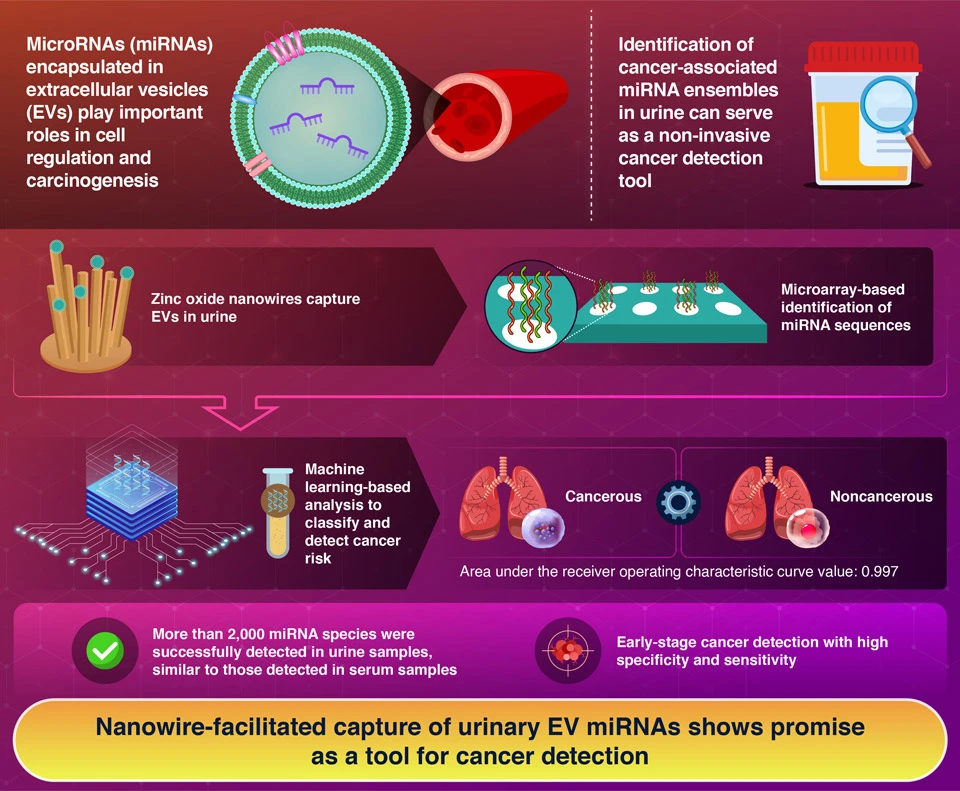Life Science and Technology News
Detecting Cancer in Urine: Nanowire-based Capture of Micro-Ribonucleic Acids
Scientists utilize machine learning-based classifiers to differentiate lung cancer and noncancer
The detection of cancer-associated micro-ribonucleic acids (miRNAs) in urine through a combination of nanowire-based miRNA extraction and machine learning (ML) analysis by researchers from Institute of Science Tokyo (Science Tokyo) can fuel the development of early-stage cancer diagnostic tools. The nanowire-based capture and extraction of miRNAs in urine enabled the detection of more than 2,000 distinct miRNA species, while the ML-based classifier accurately distinguished between cancerous and noncancerous samples.

Figure 1.
Nanowire-Based Urinary miRNA Extraction for Early Cancer Detection
Scientists utilized zinc oxide nanowires to capture cancer-associated miRNAs in urinary extracellular vesicles. By integrating machine learning analysis, they identified specific miRNA ensembles that differentiate lung cancer patients from healthy individuals, showing promise as a non-invasive, early-stage cancer detection tool. This pioneering approach could transform cancer diagnosis, enhancing patient outcomes through earlier intervention.
Cancer has a high death rate with delayed diagnosis of the disease being one of the main reasons for its fatality. Early diagnosis of cancer is vital to improving patient outcomes and in recent years, the development of diagnostic tools to detect early-stage cancer has gained a lot of attention. Cancer cells utilize specific micro-ribonucleic acids (miRNAs)-small noncoding RNAs to regulate gene expression and promote tumor formation. While circulating miRNAs are viable biomarkers of early cancer disease, the identification of cancer-related miRNAs in blood and other body fluids remains a challenge.
In this light, a team of researchers led by Professor Takao Yasui from Institute of Science Tokyo (Science Tokyo), Japan, have focused their efforts on nanowire-based miRNA extraction and machine learning (ML) analysis to detect cancer-associated miRNAs in urine. Their research findings were published online in the Analytical Chemistry![]() journal on October 18, 2024.
journal on October 18, 2024.
Nanowire-Based Non-Invasive Cancer Detection Tool

Early Cancer Detection via Multi-microRNA Profiling of Urinary Exosomes Captured by Nanowires
Yasui et al. (2024) | Analytical Chemistry | 10.1021/acs.analchem.4c02488![]()
Elaborating on the rationale behind the present research, Yasui shares, "Circulating miRNAs in the blood are mostly encapsulated in extracellular vesicles (EVs) and carry critical regulatory information. These miRNAs differ between healthy individuals and those with cancer. By utilizing zinc oxide (ZnO) nanowires to capture and extract miRNAs in urine, our research group has attempted to develop a non-invasive cancer detection tool."
Initially, the scientists utilized ZnO nanowires to capture EVs in urine samples and incorporated microarray technology to identify specific gene sequences in EV-encapsulated miRNAs. The ultracentrifugation technique was further used to compare and validate the efficiency of miRNA capture by nanowires. The results revealed that EVs containing miRNAs, including exosomes-unique subtypes of EVs with sizes ranging from 40 nm to 200 nm, were efficiently captured on nanowires. Moreover, the presence of 2,486 miRNA species was confirmed during the miRNA profiling analysis of 200 urine samples.
Driven by the discovery of more than 2,000 miRNA species in urine samples, Yasui and the team hypothesized that most of the miRNAs in blood could be transferred to urine during the filtration process in kidneys. Subsequently, they employed a logistic regression classifier constructed using ML to identify lung cancer-associated urinary miRNA ensembles. The findings revealed one particular urinary miRNA ensemble, composed of 53 miRNA species, that could differentiate cancer and noncancer subjects with very high specificity and sensitivity.
Explaining the potential applications of the research findings, Yasui states, "We also identified another urinary miRNA ensemble that could accurately detect stage-I lung cancer. Since urinary miRNA ensembles can predict early-stage lung cancer, we believe that urinary miRNA ensembles have sufficient potential to be developed as liquid biopsies for early-stage cancer prediction."
This pioneering approach to early-stage cancer detection could revolutionize diagnosis, offering new hope for improved patient outcomes and a brighter future in cancer care.
- Reference
| Authors: | Takao Yasui1,2,3,4*, Atsushi Natsume3,4,5*, Takeshi Yanagida6,7*, Kazuki Nagashima8, Takashi Washio7, Yuki Ichikawa4, Kunanon Chattrairat1, Tsuyoshi Naganawa9, Mikiko Iida3, Yotaro Kitano10, Kosuke Aoki10, Mika Mizunuma4, Taisuke Shimada2, Kazuya Takayama4, Takahiro Ochiya11, Tomoji Kawai7, and Yoshinobu Baba2,3* |
|---|---|
| Title: | Early Cancer Detection via Multi-microRNA Profiling of Urinary Exosomes Captured by Nanowires |
| Journal: | Analytical Chemistry |
| DOI: | 10.1021/acs.analchem.4c02488 |
| Affiliations: | 1 Department of Life Science and Technology, Tokyo Institute of Technology, Japan 2 Institute of Quantum Life Science, National Institutes for Quantum Science and Technology (QST), Japan 3 Institute of Nano-Life-Systems, Nagoya University, Japan 4 Craif Inc., Japan 5 Kawamura Medical Society, Japan 6 Department of Applied Chemistry, The University of Tokyo, Japan 7 The Institute of Scientific and Industrial Research, Osaka University, Japan 8 Research Institute for Electronic Science (RIES), Hokkaido University, Japan 9 Department of Biomolecular Engineering, Nagoya University, Japan 10 Department of Neurosurgery, Nagoya University, Japan 11 Department of Molecular and Cellular Medicine, Tokyo Medical University, Japan |
Related articles
- Takao Yasui|Researcher Finder - Science Tokyo STAR Search
- Yasui Laboratory
- Department of Life Science and Technology, School of Life Science and Technology
- School of Life Science and Technology | Science Tokyo organization | About Science Tokyo
- Institute of Innovation for Future Society, Nagoya University
- School of Engineering, The University of Tokyo
- Research Institute for Electronic Science, Hokkaido University
- Faculty of Business and Commerce, Kansai University
- Craif Inc.
- Tokyo Medical University
- The Institute of Scientific and Industrial Research, Osaka University
- National Institutes for Quantum Science and Technology
Further information
School of Life Science and Technology, Institute of Science Tokyo
Professor Takao Yasui
Email yasuit@bio.titech.ac.jp





